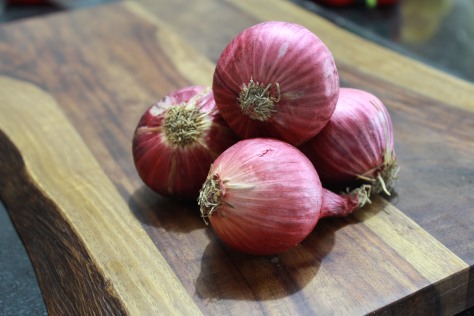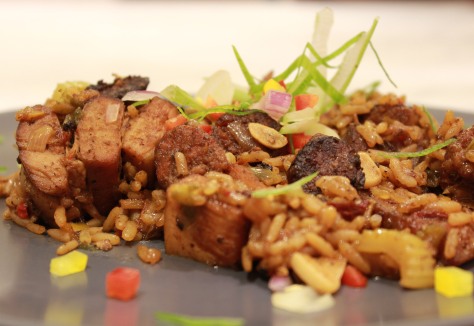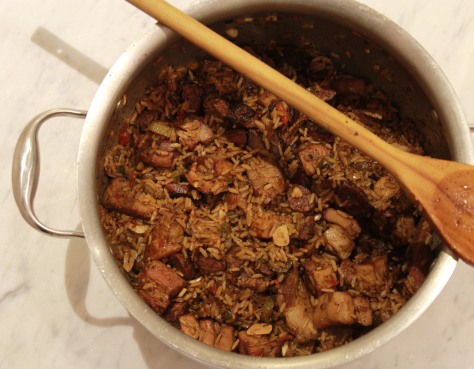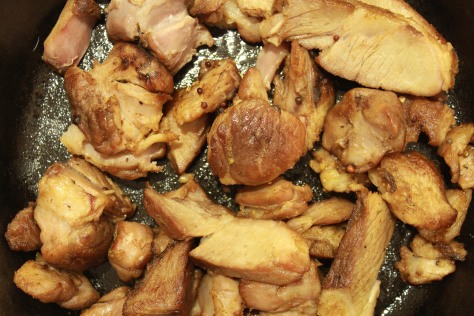Triple Pork Jambalaya


My usual recipe for Jambalaya has shrimp, chicken, and Andouille sausage. Today I will be using the Filipino favorite, Longganisa Sausages (I searched for something with as little sugar as possible) Pork Belly, and a Marinated Pork Leg (pata cut). I really enjoy my visits to the butcher, between my questions and their availability I feel like we both learn a lot from the cultural mash up. I was searching for a secret ingredient familiar in soul food called ham hock. This cut comes from the leg of the hog in the area between the ham and the ankle. The hock adds tons of savory flavor to dishes like turnip greens and beans because it contains many small bones, tendons, fat and skin. When I asked for the hock I got strange looks (as usual) but was told they had a whole leg. Here in the Philippines this part of the leg is deep dried and called crispy pata. I had them cut the lower portions into sections and the top meaty area near the ham cut into one inch thick steaks.

I prepared the meat with a 3/1 ratio of brown sugar and salt rub.

I covered with a marinade of olive oil, black mustard seed, fennel seed, star anise, black pepper, chili oil, rice vinegar, and few tablespoons of my Cajun Seasoning for some cayenne heat. I let this marry for about two hours while I prepared the pork belly, sausages, and the vegetables. Oh, and also to shoot some photos for you guys.

After braising the pork leg in the oven for a few hours on low heat. Afterwards I strained the juices while letting the meat rest.

After cooling, I trimmed the meat from the leg. I am saving the skin for making cracklin’ later.


The tendon and bones went into a sauce pot. I collected the braising drippings from the pan and gelatinous fats from between the skin and meat and placed it all into the sauce pot as well. I reduced this on medium-high heat to congeal everything. I then strained out all the solids from the liquid and continued reducing over low heat into an even thicker sauce by adding honey and rice vinegar.

I bought a lot of pork so expect triple pork sliders in a future post. But back to the Jambalaya. The pata would be providing a dense meaty flavor to the dish. I wanted something to add richness; something soft and luscious. For ingredient number two, I chose pork belly.


Rub the pork belly with liberal amounts of olive oil, course ground sea salt, course fresh ground black pepper, and a handful of brown sugar. Score the skin by cutting a quilted pattern through the skin until the fat layer. This will turn into cracklin’ as the pork bakes. Shape a sheet of aluminium foil into a rectangle with high sides and an open top to hold the drippings from the pork belly.

Place skin side up so it dries while the meat side sits in the hot rendering fats tenderising. Depending on thickness of your pork belly this usually bakes for at least an hour and thirty minutes.



Remove the belly and trim the crispy skin off. Then cut the meat into cubes.


Place the skin back in the drippings and bake until fried and crispy to your liking.
For the third little piggy I decided to use longganisa sausages. Typically longganisa is packed with sugar, so after some hunting I found a less sweet variety seasoned with garlic and herbs called Lucban.



Ok that is all for the meat course, lets move on to the veg. Louisiana has a largely Catholic population and this influence rubs off on a lot of things. The core of scores of traditional Cajun dishes begin with their version of a French mirepoix, or what is better know as the Cajun Holy Trinity.



Bell Pepper- I like to use different colored peppers for both visual aesthetic and a less overall bitter taste versus only using green. Also did you know the more red in color the bell pepper, the more vitamin C it has? Bell peppers are also very high in antioxidants, crunch crunch.
Onion- I used four onions for this dish. I prefer red onion but any color will do. The smaller and more firm red onions are the best in my opinion.

Celery- If the celery stalks still have their leaves, save them don’t throw that away! They are super tasty and good in anything from salad to salsa or just as a garnish.



And the last vegetable ingredient is the green onion or spring onion. Cut the green tops from the white bottoms. The whites are for cooking. Save the green for garnishing the plate and a fresh green crunch instead of stringy wilted mush if cooked.

Take your pork belly drippings and place them in your stock pot on medium high heat. When the grease is a hot enough temperature to induce a loud sizzle add all of the vegetables and stir. Careful not to burn yourself, the water releasing from the veggies with create a lot of steam and cause the oil to pop. Once everything is coated well and sizzling, reduce the heat and cover your stock pot for about 5 minutes. Don’t wait for the vegetable to soften too much and lose their color. At this point add all of the meat to the pot and stir gently, blending everything together.

And here is the point where I totally cheated. Let me just say that the rice here in Manila is way way different than the parboiled long grain I am familiar with in the States. The last batch of from scratch Jambalaya I made turned into 20 servings of mush. So I found this imported brand that worked brilliantly.

I let the mix come to a boil, then reduced the heat to simmer and covered the stock pot. I cooked for twenty minutes stirring once at the ten minute mark. I tested a bite of rice and it was perfect so I uncovered and removed the pot from the heat source. Time to plate!










I wish I could taste it, too! What an informative and entertaining read, Jonathan – thank you for sharing. I love your ability to adapt to what you can find there in the Philippines to achieve “at home” recipe taste results. Good job and as usual, nice presentation – especially the confetti of onions and peppers.
LikeLiked by 2 people
Wow thank you so much! Honestly I feel like pork belly really complements the dish. I highly suggest you try it the next time you make Jambalaya 🙂
LikeLike
Super proud of you bud. Keep rockin’ those Filipino kitchens 😀
LikeLike
Thanks a ton man! Good hearing from you, hope you’re doing well!
LikeLike
I’ve been good overall! Getting settled and adjusted here in Seattle.
LikeLike